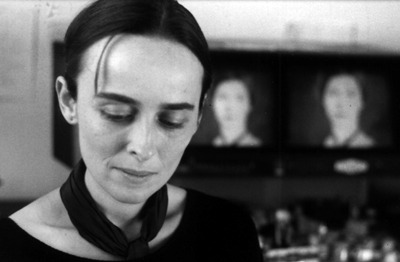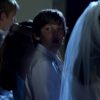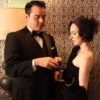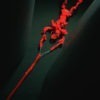
Discovering Dickinson
Written by Nicole Sawyer | Posted by: Anonymous
Whether you struggled through your high school English class or have had a lifelong passion for poetry, Jim Wolpaw and Steve Gentile have made the film for you.
An hour-long documentary co-produced by Wolpaw and Gentile, "Loaded Gun: Life, and Death, and Dickinson–" explores the contemporary appeal of one of the most interesting poets in 19th century American literature. Presenting a variety of interpretations of Emily Dickinson’s life and work in a quirky, playful manner, the filmmakers originally intended to engage an audience that would normally shy away from poetry. Yet as the project developed, they found that they had something special to offer even the most ardent Dickinson fan.
Writer/director Jim Wolpaw acknowledges the questions that have baffled Dickinson scholars for decades and also raises a few questions of his own that reach beyond the generally accepted views of the poet. He imagines a Hollywood film scenario based on Dickinson’s life and holds "auditions" with 30 actresses aspiring to play her in the film. The director tells them to improv as the poet and asks them a series of blunt questions designed to draw out their conceptions of who this enigmatic figure was: "Are you in love with death?"; "Do you have a problem with God?"; "Why don’t you ever leave your house?" These questions result in a wildly amusing look at the poet’s place in present-day culture.
Their responses are intercut with footage of experts (of varying degrees of authority) discussing their interpretations of Dickinson. These experts include four psychiatrists with differing opinions of her personality, or personality disorders; biographer Polly Longsworth; a "sensitive" from Dickinson’s hometown of Amherst, Mass. that believes she knows about the poet’s past incarnations; U.S. Poet Laureate Billy Collins, who reads his poem "Taking Off Emily Dickinson’s Clothes"; actress Julie Harris, who portrays the poet in the one-woman show "The Belle of Amherst"; artist Leslie Dill, whose paintings and photographs include words from Dickinson’s poems; and a university student with a tattoo of Dickinson on his back. The film also includes a rock band performing their version of the poem "My life had stood – a Loaded Gun –," from which the film derives its title; and images of Dickinson playing baseball and engaging in a shoot-out with an alter-ego, to name just a few of the offbeat approaches Wolpaw takes to his subject.
Originally conceived as a half-hour film, Wolpaw and Gentile expanded the scope to include more of the surprising wealth of material they had at their disposal. Wolpaw, who earned an Oscar nomination for his 1985 short film "Keats and His Nightingale: A Blind Date," comments that one of the most interesting and unexpectedly rich aspects of the project was "getting the variety of takes from the actresses" who knew little or nothing about Dickinson before the auditions. He also notes that the expert opinions were invaluable and added a great deal to his investigation of the poet.
Gentile, who took care of all camera, lighting, and sound concerns, agrees that meeting and interviewing this eclectic group of people proved to be one of the greatest rewards of making the film. "Billy Collins is a hoot," he jokes. "He really cuts through the crap and also has a lot of deeply relevant things to say. And Julie Harris, wow! What an honor to have her in the film. She was so giving of her time." He gives appreciative credit to "our die-hard associate producer" Lisa Perkins, whose work included the difficult task of securing this talent.
Despite the light tone of the film, Wolpaw and Gentile manage to include a good deal of essential biographical and academic information and still be quite serious about the issues they deal with. Putting all of this together in a meaningful way was not easy. "Finding the structure of the film is what we really fought with," says Wolpaw. "With so much material, the challenge was hot to bring it together in a way that made sense." This difficulty led to long editing process, which Gentile recalls as "just the two of us, locked up for several years. I don’t think a single idea in this film went unchecked by either of us. It may sound like a pain, but it makes for a better film in the end. We each served to reign the other in when an idea became too wacky or extraneous."
These filmmakers made a great team, Wolpaw bringing his longtime interest in Dickinson to the project, while Gentile had little knowledge of the poet before working on "Loaded Gun." Wolpaw says that he has been "toying with the idea of the film for a long time, about 15 years. I thought it would be a challenge for a film" to work with Dickinson’s poetry. Gentile, however, was one of the uninitiated that the film aims to draw into her work. He says that Wolpaw "started slipping me some of Emily Dickinson’s poems about 10 years ago. I was sort of the quintessential ‘poetry phobe’ at the time. I think Emily ended up getting under my skin, as she is wont to do."
Their collaboration resulted in what Wolpaw calls a "non-traditional, you might even say experimental film," which nevertheless appeals to the general public as well as film and poetry aficionados. "Audience response has been overwhelmingly positive," says Gentile. "A lot of people return to screenings with friends in tow, and the friends always seem to say, ‘Wow, that was better than I ever imagined it would be…’ But it also turns out that Dickinson experts keep re-screening the film, because we did pack it with a ton of information. There are at least 50 poems represented, even if in part, and it’s always a revelation to hear the work read aloud, no matter how involved an expert you are." He attributes this broad appeal to the way the film plays with documentary conventions but at the same time uses them as a device to convey a wide range of data and views on the poet.
They managed to do all of this on roughly "25 percent of what the same thing might be made for at, say, WGBH," says Gentile. Their methods produced a spontaneous and intimate as well as intelligent film, true to the spirit of Dickinson’s work. For instance, they discussed hiring professional voice-over artists, "but it just didn’t make sense," Gentile says. They used Wolpaw’s voice instead because "there had to be a certain sincerity to that voice. Jim may not have wanted to do it, and its kind of my fault for pushing him to do it. I think he gives the film a certain homemade warmth."
The film may not come to any more definite conclusions to the issues it raises than the years of scholarly investigation have produced. Yet the sincerity, originality, and wit of "Loaded Gun" is sure to inspire a new wave of Dickinson fans, and fans of poetry in general.
'Loaded Gun: Life, and Death, and Dickinson–' is showing at the Museum of Fine Arts in Boston on Friday, October 4 at 6:30 p.m. and Saturday, October 5 at 1:15 p.m. Call 617-369-3907 for more information.











